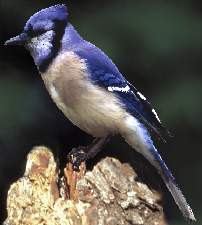Blue Jay
Blue Jays are attracted to feeders and water in the
backyard, just like many of our other favorite songbirds.
Identification and Pictures
Blue Jays (Cyanocitta cristata) are a
very attractive bird, a little larger than an American robin,
about 11 to 12 inches. Both male, and female are blue above
with a crest, and a black necklace. The wings and tail have
spotted white, and black markings. They are dull gray to
whitish below.
Habitat
They can be found in woodlands, parks, and your
backyard feeders across central and eastern U.S., and southern
Canada year round. They have a wide expanding range in the western U.S. and much
of southern Canada.
Breeding and Nesting

photo Dave Menke US Wildlife
|
Breeding season is April to May. They
breed in mixed wooded areas usually near open space.
They like oaks and, pinewoods as well as gardens.
Nests are built in trees or shrubs, sometimes in a
tree cavity. Both adults will build a nest with
twigs, grass, strips of bark, feathers, rags,
and even paper. Mud may be used as mortar. |
Blue Jays can have more than one brood in a
season. The
female will incubate 4 to 6 eggs. Eggs are smooth and glossy.
They can be pinkish, green, bluish, or pale olive. They are
specked with brown, olive or purple.
The young birds are attended by both adults, and can leave the
nest in around 3 weeks.
Blue Jay Song
Blue Jay call: Click for Sound
Blue Jay Too-lool Click for
Sound
They are a very noisy bird with a harsh jay, or a musical
wheeedlee or too-lool. Soft nasal notes are given when
the birds are close. Blue jays will often mimic the
call of hawks. They will often do this at feeders to
scare the other birds away, then the jays will take over the
feeder.
Food and Feeders
Along with goldfinches, juncos, Tree sparrows,
and others, Blue jays will visit your backyard feeders.
Some people would just as soon not have Blue
Jays at their feeders because they consider them
bullies. It seems that in some areas they have these
aggressive traits, and in others they don't.
For more on food
and feeding click here.
For more on feeders click here.
To learn about other favorite
birds click here.

|
